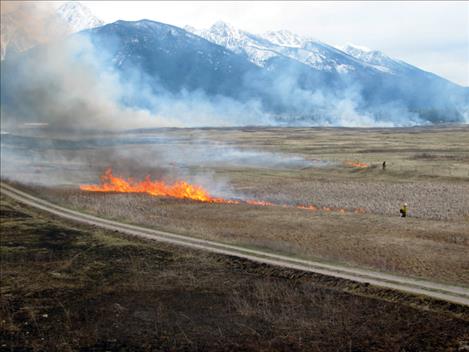Prescribed burns benefit wildlife habitat
Hey savvy news reader! Thanks for choosing local.
You are now reading
1 of 3 free articles.
News from the Confederated Salish and Kootenai Tribes’ Natural Resources Department
RONAN — Where there’s smoke, there’s fire. And where there’s fire, at least on a Tribal Wildlife Management Program wildlife habitat restoration land, there’s usually a prescribed burn — one of the best and most cost-effective methods of managing habitat for wildlife.
Tribal Wildlife Program collaborates with Tribal Division of Fire on conducting prescribed burns. The Wildlife Program identifies and maps the areas they would like to burn and Division of Fire prepares the burn plan, determines when conditions are appropriate and then they carry out the burn. The Wildlife and Fire Programs have a long and productive working relationship.
A prescribed burn, or an intentional burning of vegetation under strict and specific circumstances, helps restore and maintain wildlife habitat. It is a cost-effective tool that Tribal Wildlife Management Program staff uses to create and maintain suitable and ample wildlife habitat in prairie pothole, native grasslands and open-canopy woodlands throughout the reservation.
The most common prescribed burns the Tribal Wildlife Program conducts are restoration burns and maintenance burns. Restoration burns, as their name implies, are done on fire-dependent habitats that haven’t been burned in years. They help prepare a site for restoration planting. Maintenance burns are repeated burns that restore and maintain fire-adapted habitats.
Wildlife staff typically conducts maintenance burns in five- to seven-year cycles to remove thatch and open groundcover for many grassland birds and waterfowl. This attempts to mimic the interval of fire that would have occurred naturally in these areas if natural fires were allowed to burn. We burn parts of one large area in a single year and then we rotate areas to burn over several years. This leaves a patchwork quilt of habitat, each patch in a different stage of regrowth. Different wildlife species are attracted to these different growth conditions.
“Having a lot of native grasses and prairie wildflowers provides valuable food and cover for a wide variety of wildlife species as well as insects and pollinators,” said Art Soukkala, the wildlife program’s wildlife biologist involved in restoring habitat on mitigation parcels. “Prairie birds, including upland gamebirds and waterfowl, use the groundcover for nesting. During the nesting season the insect populations provide an important protein source for growing nestlings.” Soukkala said. “Later in the year songbirds and small mammals utilize seeds and berries produced by native plants. Deer browse on shrubs and feed on a variety of grassland plants.”
In fact, many of the Flathead Reservation’s declining or rare wildlife species are adapted to and found only in fire-dependent grassland habitat, which underscores the need for the Wildlife Program to continue its prescribed burn program across the reservation. Long billed Curlew, Sandhill Cranes and Peregrine Falcons as well as sensitive plants, such as Blue Camas, all benefit from periodic fire.
“Our native prairies typically support a mix of long lived perennial grasses, legumes, wildflowers, and shrubs, all of which provide excellent food and cover for many species of wildlife,” Soukkala said. “After we burn an area, we typically see a rapid regrowth. Our burns only take off the above-ground parts of plants. The deep-rooted perennial grasses and forbs quickly regrow as they take advantage of the new openings and nutrients released by the fire and shrubs quickly re-sprout. Some species of wildlife move back in the next day. Other species move back in over the weeks as the regrowth progresses.”
To an untrained eye, the land after a prescribed burn can look bleak — a smoldering, bare landscape in which no animal could have survived. That misperception, however, can’t be further from the truth.
“Some people may be concerned about animals not being able to escape the fire, particularly in the spring,” Soukkala said. “We burn as early as we can in the spring, before the nesting season begins for grassland birds. Our fires are slow moving because we won’t burn when winds are high. Burning in the spring also results in a cooler fire that won’t scorch the ground like a fire in August might. This gives animals time and room to escape.”
Wildlife evolved over the centuries with fire and they learned how to avoid and escape fire. Larger mammals and birds leave the area of the fire. Smaller mammals, reptiles and amphibians are already burrowed in the ground and remain there until the fire burns over, according to Soukkala.
“The overall benefit that wildlife receives from a prescribed burn far outweighs the risk to individual animals that may be lost,” Soukkala said. “It’s not only wildlife that benefits from burns, either. Folks who come out to our prairie restoration areas after they have been burned will find more wildlife and better habitat conditions where they can hunt and observe wildlife.”
The Kicking Horse prescribed burn project is funded by Kerr Dam wildlife mitigation funds, derived from the settlement agreement for the adverse impacts upon wildlife and habitat caused by the dam operation. For additional information on wildlife management in mitigation areas where wildlife habitat restoration has included prescribed fire contact Art Soukkala or Germaine White at (406) 675-2700.
















